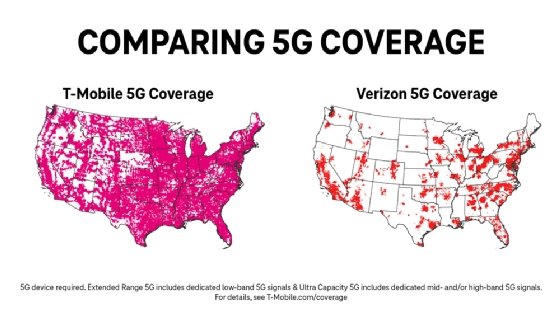
Getty Images
T-Mobile expands fastest 5G coverage to 260 million
T-Mobile has expanded its mid-band 5G coverage across most of the nation, pulling further ahead of rivals Verizon and AT&T.
T-Mobile's fastest 5G service has reached 260 million customers nationwide, giving the wireless carrier a significant lead over AT&T and Verizon.
T-Mobile reported this week that its mid-band Ultra Capacity 5G has 260 million customers, while its slower low-band product, Extended Range 5G, reached 323 million. To help it grow the Ultra Capacity service faster, the company said it added the 1,900 MHz spectrum. T-Mobile has a goal of covering 300 million people with Ultra Capacity 5G by the end of 2023.
AT&T and Verizon do not release their 5G subscriber numbers. However, in October, AT&T expected its 5G service to reach 130 million people by the end of the year, and Verizon said its 5G Ultra Wideband service reached 30 million households.
According to a nationwide report by Umlaut, a consultancy owned by IT and professional services company Accenture, T-Mobile has the highest 5G score for coverage, stability and reliability, as well as download and upload speeds. Umlaut's "5G Network Performance" report, conducted between April and September 2022, concluded that T-Mobile achieved the highest 5G score nationwide.
T-Mobile got an 18-month head start on mid-band 5G ownership when it acquired Sprint in 2020, according to IDC research manager Jason Leigh. Meanwhile, competitors Verizon and AT&T had to fight for the C-band spectrum critical for 5G connectivity in an auction held by the Federal Communications Commission. The carriers lost more time waiting for the spectrum to be cleared for ownership, pushing deployment to January 2022.
"They're playing catch-up," Leigh said.
There are two versions of carrier 5G: nonstandalone and standalone. Nonstandalone 5G transmits signals according to 5G standards. However, once the signals hit the radio tower, they travel through the old LTE networking infrastructure of T-Mobile, Verizon or AT&T.

T-Mobile is the leading provider of standalone 5G, which does not require legacy infrastructure. It is also valuable because it offers network slicing, which delegates different topologies to different purposes. For example, slices might provide different gigabit speeds, while an unsliced network is more variable in terms of guaranteed speeds. Network slicing also connects services to the necessary resources on a 5G network.
"Some of the things that you can do in the network that really get latency low, you can't do until you get to 5G standalone," Leigh said.
Operators are beginning to monetize 5G by offering broadband wirelessly through fixed wireless access, according to Leigh. Through fixed wireless access, consumers use a router or outdoor antenna to broadcast Wi-Fi in the house wirelessly.
"T-Mobile, because of their mid-band, has been running like gangbusters to deploy this," he said. "They're adding more wireless broadband subscribers every quarter than the rest of the wired industry combined."
Verizon also offers fixed wireless access to consumers through its 5G Home plan.
T-Mobile's nationwide wireless broadband service appeals to franchises with multiple locations in different cities or states, Leigh said. Before the wireless option, the broadband provider might vary from site to site. But if the franchise owner switches to T-Mobile, one provider offers the same price to all locations.
"Things like that are going to be very appealing," he said.
Mary Reines joined TechTarget in October 2022 as a news writer covering networking. Prior to TechTarget, Reines worked for five years as arts editor at the Marblehead Reporter, her hometown newspaper. She received her bachelor's in journalism from the University of Massachusetts Amherst, where she served as an assistant news editor for the student newspaper, the Daily Collegian.








